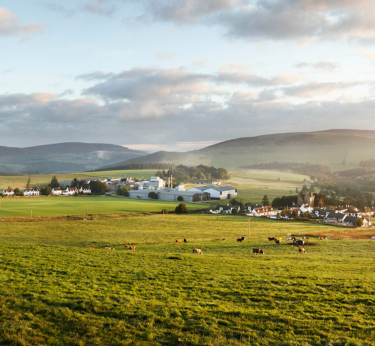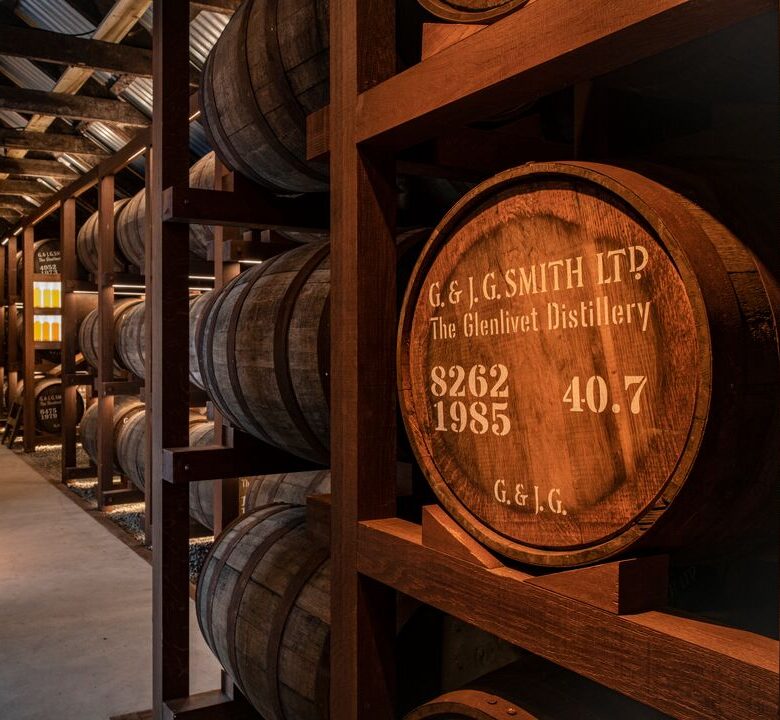
The complexity of a dram is about more than just what whisky is made from. The cask maturation process, where science, wood, and time converge, is pivotal in creating the distinctive amber nectar that we know and love.
Whisky maturation, akin to a flavourful tango, is not just a waiting game; it’s a delightful transformation that unfolds within the confines of oak barrels. So, if you’ve ever wondered why some whiskies, like our Founder’s Reserve smooth scotch whisky, boast a creamy sweetness while others, such as our 15-year-old single-cask scotch carry a hint of sherry warmth, this guide is for you.
We dive into the chemistry behind this masterful symphony, where wood imparts its wisdom, and spirits take on new identities and explore the key aspects that influence the cask maturation process.
How does whisky mature?
Whisky maturation, which is also commonly referred to as ageing, occurs when the spirit is stored in wooden casks. During this time, the wood of the cask and spirit held inside interact, with the wood giving flavours, colours, and aromas to the whisky while also removing undesirable traits.
What are the chemical mechanisms of whisky maturation?
While the whisky sits inside wooden casks, magic is occurring. A complex and amazing plethora of chemical transformations shape the flavour, aroma, and colour of the final spirit.
Whisky maturation has three distinct branches: additive, subtractive and interactive maturation. Let’s delve in.
Additive maturation
As the name might imply, additive maturation refers to how the wood of the cask gives characteristics to the whisky. There are many things at play here including:
Lignins
Lignins are organic polymers which provide strength and stability to wood. However, in the presence of alcohol, they break down, releasing aromatic compounds that contribute to the whisky. Different compounds create different profiles. Guaicacol, for instance, is smoky, whereas phenylethanol is more floral and vanillin imparts a hint of vanilla and contributes sweetness.
Tannins
These compounds are important for the mouthfeel of whisky. They provide astringency, which is that dry sensation you get in your mouth. Tannins also help stabilise the colour of the spirit and remove unpleasant sulphurry notes.
Hemicellulose
Hemicellulose is one of the components found in the cell walls of wood. While it may not be as well-known as lignin, hemicellulose plays a crucial role in contributing to the character of whisky during the cask maturation process.
Hemicellulose contains various sugar polymers, such as xylose, mannose, and glucose. During whisky maturation, these sugars are released from the wood and dissolve into the spirit, adding caramel, toffee, and honey-like sweetness. Hemicellulose also contributes to a smoother and fuller mouthfeel.
Subtractive maturation
This aspect of maturation relates to the processes during which undesirable or harsh characteristics present in the raw whisky spirit, such as dimethyl disulphide and congeners, are diminished or removed as the whisky interacts with the wooden cask during maturation.
This phase is a crucial aspect of whisky development where the wood acts as a filter, contributing to the refinement and smoothness of the final product.
Interactive maturation
As well as exchanges that occur between the whisky and the wooden cask, there are also processes that occur within the spirit itself and with the environment during maturation.
Oxidation, for example, driven by the porous nature of wood, introduces subtle changes over time, enhancing the whisky’s character.
Esterification involves the formation of esters, contributing fruity and floral aromas. While most esters are formed in the copper pot stills during distillation, they are also created during maturation.
Due to the wooden cask being porous, evaporation also occurs, with some of the liquid inside leaving the cask and entering the atmosphere. The small amount lost is known as angel’s share whisky.
What factors impact the cask maturation process?
The interaction between the whisky and the wood is paramount to the cask maturation process but there’s even more to it than that. The nuances of flavour, aroma and colour are expertly curated by whisky producers through conscious and careful consideration of a range of parameters:
Wood type
Whisky is predominantly matured in oak casks. This is because oak provides a balance of porosity and flavour components. However, there are many varieties of oak including American and European and the type used influences the finished spirit. European oak adds spicy and woody notes while American oak provides the taste of vanilla and coconut.
Cask size and shape
The cask selection for whisky maturation is an important one. Smaller casks have a larger surface area relative to volume, leading to faster maturation. Cask shapes may also influence flavour extraction.
Cask freshness
Whisky casks are robust vessels and are used for years and years. This means that some whiskies will be matured in casks that have previously housed other expressions. These casks, known as 2nd fill, 3rd fill or refill casks, impart more subtle flavours and do so slower than 1st fill casks that haven’t been used previously. 1st fill casks require careful monitoring so that the whisky doesn’t end up becoming overpowered by the compounds the wood introduces to the spirit.
Previous contents of the cask
Whether the whisky cask has been previously used for ageing other spirits such as sherry or bourbon further impacts the profile of the whisky. The Glenlivet Caribbean Reserve single malt scotch, for example, is selectively finished in barrels that previously held Caribbean rum. This results in a whisky that has a bold, tropical flavour.
Environmental conditions
Factors like temperature and humidity further influence the rate of maturation. Warmer climates generally result in more rapid ageing due to increased interaction with the wood. That’s why there’s a difference in the character of whiskies produced in Scotland, which has a relatively cool and damp climate compared to those matured in the humid summers and cold winters of Kentucky, USA.
How long must whisky be matured?
The minimum maturation period varies by region and regulations. For example, when it comes to how scotch is made, The Scotch Whisky Regulations 2009 stipulate it requires a minimum of three years of maturation in the cask. Straight bourbon whisky, however, must be aged for a minimum of two years.
Many whiskies benefit from longer ageing, with some premium releases maturing for several decades. Extended maturation allows for greater complexity and depth in flavour. The Glenlivet’s 33-year-old cellar collection expression, for instance, is one of our most rare whiskies. It’s aged for a minimum of 33 years and has an intense, dark amber hue and rich, fruity flavour as a result.
Does whisky mature in the bottle?
No, once bottled, whisky stops maturing. The ageing process is halted because the spirit is no longer in contact with the wood. However, whisky can undergo subtle changes in the bottle due to oxidation, especially if the bottle is not sealed properly. Over many years, exposure to air can lead to very gradual alterations in flavour and aroma, though this is a slow and minimal process compared to cask maturation.
If you want to learn more about how important the cask is in the production of whisky, read our guide to cask strength or find out whether double cask is better than single cask. Of course, you can always experience for yourself how the cask maturation process influences the finished spirit by sampling some whisky cocktails.




